


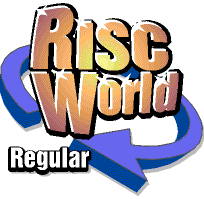
The Education Column
Andrew Harmsworth with the latest Education news
In December 2003, Alligata Software took over the rights to the RISC OS line of Topologika's educational software. Over the next few issues, we'll be taking a critical look at their Educational Essentials range, beginning with Alphapics & Numberpics.
Topologika to Alligata
Last December, Alligata Software's David Bradforth announced that they had taken over the right to sell, support and distribute the RISC OS line of Topologika's educational software. With the market for RISC OS in education seemingly in freefall, this was a welcome move to help maintain the use of many machines that would otherwise be on their way to the skip sooner rather than later.
Educational Essentials is an extensive range of realistically-priced software (£19·90 each, inc. VAT), now all being supplied on CD-ROM. Primarily addressing numeracy and literacy, there are more than enough titles to keep primary school children busy for quite some time.
Alphapics & Numberpics
Alphapics & Numberpics cover a range of number recognition and picture-to-letter matching activities for early years children (ages 3-7). Both were originally designed by the Northamptonshire Computer Education Centre with (what appears to be) an original release date of 1996.
On opening the CD, one is presented with an !Install application, manual folder and ReadMe file:

Fig. 1: Contents of CD window.
I always think it's good practice to have such installation programs, even if all they're doing is copying applications directly over onto your hard-drive (in this case, it's not).

Fig. 2: Installation window.
You have a choice of installing either or both of the programs together, which is a nice touch. Chances are you'll want both.
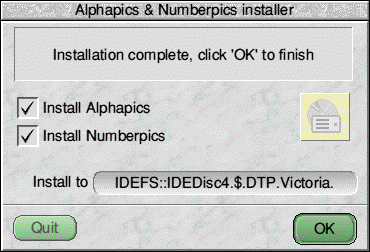
Fig. 3: Installation complete!
Having installed them both, I quickly fired up Alphapics. Unfortunately, this produced an error and it failed to load (test machine is a StrongARM RiscPC, RISC OS 4.37). Loading up the manual, the hardware requirements are indicated as thus:
"NumberPics and AlphaPics for RISC OS require a 2mb Acorn computer running RISC OS 3.1 or above. They should be viewed in a 256 colour mode, eg mode 28 or 15."
On changing to a 256 colour screen mode, it loaded fine. Just in case I'd been running something unfriendly, I re-booted the machine (back into 1024×768 with 32,000 colours). AlphaPics loaded first time! The welcome screen is professional and it is accompanied by a pre-recorded welcome message that is spoken to you:
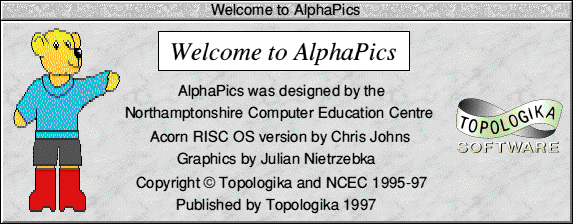
Fig. 4: AlphaPics Welcome Screen
The program then loads straight to the iconbar. On clicking upon its icon, you are asked to type in your name (which is also spoken by the computer):

Fig. 5: Name entry window
The program is capable of remembering how well each user has done, essential for teachers as there is so much monitoring of progress to be recorded these days. Various options are of course available via MENU on its icon:
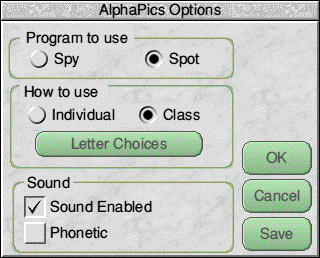
Fig. 6: Options window
There are two types of tests that can be done: spot or spy. If the phonetic option is enabled as well, you can use the right mouse button on each of the 4 letters to hear how they sound. Right clicking the object repeats the spoken word.
You can even choose which letter to include in the test, which is potentially useful for concentrating on letters that pupils are struggling to learn, or with those that they're regularly muddling up. Also, early years reading schemes (such as Jolly Phonics) often begin by teaching pupils a selection of letters (e.g. a, i, p, s, t):
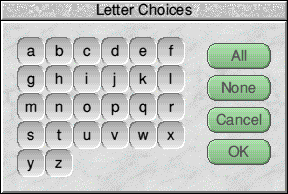
Fig. 7: Choosing letters
Finally, changing between class and individual removes the tracking of individual progress, taking users directly to the selected activity.
Spot
With spot, an object is presented to you (spoken as well if you have sound enabled) and you have to spot which letter it begins with (out of a list of 4).
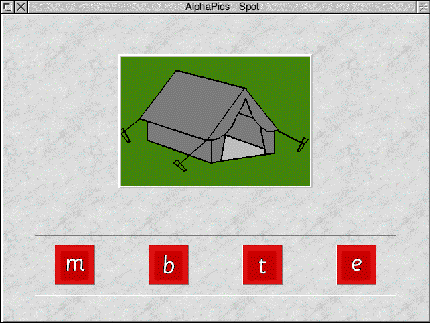
Fig. 8: Tent - but can you spot its first letter?
Although the quality of the graphic here has been made worse by shrinking the window, it isn't much better full size!
The choice of letters offered by spot appears to be random. It would prove a more useful teaching aid if similarly written or sounding letters could appear on offer, e.g. c and k, v and w, etc.
Spy
With spy, pupils are presented with a letter (spoken) and 4 objects. They have to spy which one begins with the given letter. As with spot, using the right mouse button on the ? or letter speaks the object or letter. It would be more natural, however, to allow the clicks to be on the objects. That said, perhaps the authors were hoping to improve users mousing skills?
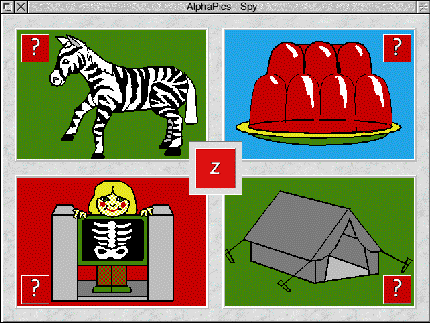
Fig. 9: The letter z - and familiar objects
Both spy and spot call upon the same set of graphics, so whilst changing between the tests does offer a wider range of activities (2 instead of 1), unfortunately there is too big a danger of "seen it all before" syndrome.
Limited Graphics
AlphaPics uses mode 27 (16 colour) graphics that come as Squashed sprite files inside the application. Unfortunately there is only one object per letter in the alphabet. This seriously limits the usefulness of the program as it currently stands, as if pupils are to be presented with only a small number of letters (perhaps ones which they muddle up like d and b, p and q, etc.) they'll soon get bored of seeing the same graphics each time.

Fig. 10: 26 objects for 26 letters
That the graphics are squashed sprites should, however, mean that the program could easily have them replaced with more modern examples. Whether it could easily be adapted to pick randomly from more than one graphic beginning with the same letter is perhaps a harder request.
Pupils records
Pupils' progress can be monitored either on screen or printed out. This is an essential and welcome feature that works well.
NumberPics
As with AlphaPics, your are greeted by a welcome screen accompanied by a pre-recorded message:
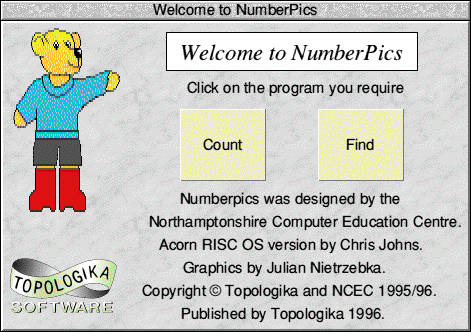
Fig. 11: NumberPics Welcome Screen
Unlike AlphaPics, you are offered the choice between its two activities - count and find - straight away (avoiding the need to find the options). In fact, when in use NumberPics greys out the menu options, whereas AlphaPics does not - selecting them just throws up an error message. It would be great if both programs had a consistent interface, from the welcome screen through to iconbar menu behaviour.
Count
The idea behind count is simply to show you a number of objects and get the user to count them. They then have to choose which number matches the number of objects:
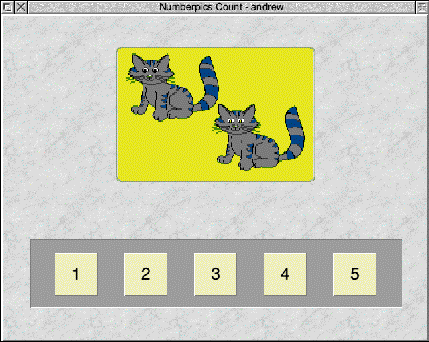
Fig. 12: Nice pussies - but how many are there?
Get it wrong, and the computer counts the objects for you (speaking them if chosen) and displaying the numbers as it goes. Get it wrong again, and it shows you the correct answer - before moving on to the next task.
Various number ranges are available from the options screen: 0-4, 1-5, 0-9 and 1-10. Shown below the set-up of my RiscPC has problems coping with the display of this window. It does, however, work and is obvious:
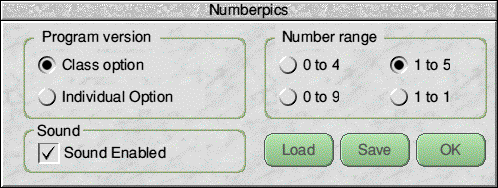
Fig. 13: Options window for NumberPics
Once again, the class option will keep track of individuals, whereas the individual option just lets you get on with it.
Better Variety
Unlike AlphaPics, which was limited to one graphic per letter, NumberPics appears to display all objects a multiple number of times. So, for instance, you might get two lions for 2 one time, then two apples when you see it again. This is excellent and how it should be. The possibility of always having two apples for the number 2 was one I hoped wouldn't happen!
Find - can't find!
Unlike AlphaPics, swapping to the alternative task cannot happen through menus or option windows. Instead, the program has to be quit from the iconbar and reloaded. Perhaps right-clicking the iconbar icon could load up the welcome screen to avoid this? Furthermore, the iconbar icon changes depending on whether choose or find is in play.
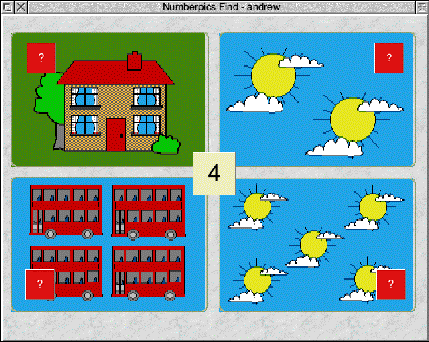
Fig. 14: Can you find 4 of something?
Like choose, find is able to display multiple numbers of objects from the same graphic file. Unlike AlphaPics, these are all contained within one Data file inside the application - so enhancement of these may not be easy.
As with AlphaPics, the mouse must be clicked on the small red square with a question mark in. It would seem more natural to be able to select the images themselves.
Right clicking each question mark speaks the number of objects in the window. Obviously this is very helpful, but can be turned off if sound is inactivated.
Conclusions
It's all too easy to be critical of older educational titles that have been given new lease of life on the RISC OS platform. Perhaps the best way of concluding things is to draw up a list of pro's and con's:
| Pro's | Con's |
|---|---|
|
|
|
Overall these programs are satisfactory - to borrow an Ofsted phrase - but they ought to be at least good. To be good, they need some updating and as I've highlighted some of this would be relatively easy. They are worthwhile, although we would suggest that aiming them at 3-7 year olds is too wide an age range. Both are appropriate for 3-5 year olds making normal progress, no higher.
Hopefully come next issue I'll be able to report back on what its new developers think about what we've had to say this issue. I can't, however, offer either of these titles the RISCWorld "highly recommended" seal of approval in their current guises. Better luck next time!
If you have any questions or comments on the use of RISC OS computers in education, please either email education@harmsy.freeuk.com or better still join the RISC OS Education Discussion List, and air them there.
Andrew Harmsworth